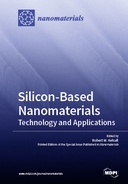Explore

Silicon has been proven to be remarkably resilient as a commercial electronic material. The microelectronics industry has harnessed nanotechnology to continually push the performance limits of silicon devices and integrated circuits. Rather than shrinking its market share, silicon is displacing “competitor” semiconductors in domains such as high-frequency electronics and integrated photonics. There are strong business drivers underlying these trends; however, an important contribution is also being made by research groups worldwide, who are developing new configurations, designs, and applications of silicon-based nanoscale and nanostructured materials. This Special Issue features a selection of papers which illustrate recent advances in the preparation of chemically or physically engineered silicon-based nanostructures and their application in electronic, photonic, and mechanical systems.
This book is included in DOAB.
Why read this book? Have your say.
You must be logged in to comment.
Rights Information
Are you the author or publisher of this work? If so, you can claim it as yours by registering as an Unglue.it rights holder.Downloads
This work has been downloaded 187 times via unglue.it ebook links.
- 31 - pdf (CC BY-NC-ND) at Unglue.it.
Keywords
- C/C composites
- electroluminescence enhancement
- fluctuating temperature-humidity conditions
- gold nanoparticles
- graphene oxide
- group-IV semiconductors
- in-situ growth
- light emitting devices
- localized surface plasmon resonances
- long-term mechanical tests
- Mechanical properties
- micro-mechanism
- nano silica sol
- nanofabrication
- nanomembranes
- Nanoparticles
- Nanowires
- ohmic contact
- optical gain media
- quantum photonics
- self-aligned nanowires
- self-assembly
- SiC nanowires
- Silicon
- silicon carbide
- silicon quantum dots
- single-crystal Si nanomembrane (Si NMs)
- strain engineering
- telecom wavelengths
- thermal reduction
- thin film transistor
- TiO2 insertion layer
- ultrathin nanowires
Links
DOI: 10.3390/books978-3-03921-043-5Editions


